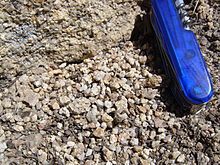User:Rocksandwaves/sandbox
Weathering
[edit]
Physical weathering occurs on a large scale in the form of exfoliation joints, which are the result of granite expanding and fracturing as pressure is relieved when overlying material is removed by erosion or other processes.
Chemical weathering of granite occurs when dilute carbonic acid, and other acids present in rain and soil waters, readily alter feldspar in a process called hydrolysis.[1][2] As demonstrated in the following reaction, this causes potassium feldspar to form kaolinite, with potassium ions, bicarbonate and silica in solution as byproducts. An endproduct of granite weathering is grus, which is often made up of coarse-grained fragments of disintegrated granite.
- 2 KAlSi3O8 + 2 H2CO3 + 9 H2O => Al2Si2O5(OH)4 + 4 H4SiO4 + 2 K+ + 2 HCO3−

Climatic variations also influence the weathering rate of granites. For about two thousand years, the relief engravings on Cleopatra's Needle obelisk had survived the arid conditions of its origin prior to its transfer to London. Within two hundred years, the red granite has drastically deteriorated in its new moist climate.[citation needed]
- ^ "Granite [Weathering]". University College London. Retrieved 10 July 2014.
- ^ "Hydrolysis". Geological Society of London. Retrieved 10 July 2014.
